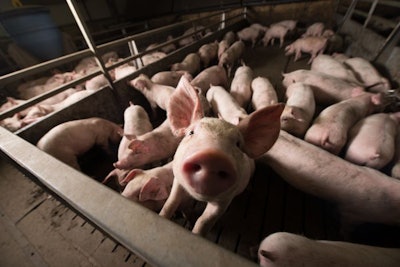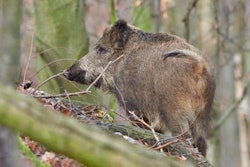
Biosecurity is key to prevention, while large-scale depopulation and disposal was a major challenge early in pandemic
African swine fever (ASF) has never been detected in the U.S., but the country still faces several challenges in preventing and monitoring a potential future outbreak, according to experts.
Biosecurity is the most important aspect of ASF prevention, according to Andriy Rozstalnyy, animal health officer at the Food and Agriculture Organization of the United Nations (FAO), who spoke last week during the U.S. Department of Agriculture’s (USDA) 97th annual Agricultural Outlook Forum. Biosecurity starts with border inspection and continues through to fences, gates and other equipment, as well as the proper mindset from personnel and other people involved.
He said that, while disease surveillance is important, there is a lack of incentive for farmers to report suspected cases of ASF in many countries.
“Based on studies done in Europe, epidemic or passive surveillance has at least 55 times more probabilities to early detect the virus in respect to any active surveillance,” he said. “Therefore, sick or dead pigs and found dead wild pigs should be the main target for early detection.”
Controlling the disease in a challenge in countries that have been affected by ASF because “control is based on stamping-out policy and it doesn’t work in many countries due to lack of timely and fair compensation,” Rozstalnyy said, adding that movement control and quarantine are expensive and challenging to implement.
Depopulation and disposal of carcasses and disinfection are also challenging because they require preparedness and skilled personnel and equipment and coordination.
Rozstalnyy said continuous high awareness and engagement of all involved stakeholders is crucial for early detection and improved biosecurity.
Key challenges for US
Rozstalnyy addressed several challenges the U.S. faces in keeping the country free from ASF.
“First, it’s important to know where your pigs and where animals and pork products are moving to, so registration and traceability are important,” he said. “Do you have updated registry of farms, suppliers, slaughterhouses, markets? Does the traceability system provide reliable and timely data on all movements of pigs, pork products?”
Regarding surveillance and control, he said it is important to keep in mind the importance of a compensation fund.
“It’s important that all procedures are clear and quick with regards to compensation; it’s important that staff is regularly trained on surveillance, diagnostics and outbreak management,” Rozstalnyy said. “And, if you have practiced to have a simulation exercise to check this preparedness, what was the outcome and which adjustments have been made off of this simulation exercise?”
Feral pigs pose an additional challenge “because timely detection in wild or feral pigs is almost impossible because it’s expected to detect on the peak of the ASF epidemic rather than at the incursion phase,” he said. “And due to the abundance of feral pigs, it’s important to have a biosecurity program in case of ASF detection in feral pigs.”
Hunters and farmers should be educated about the risks of ASF, Rozstalnyy said.
“Feral pig eradication programs would be seriously challenged by the presence of ASF, so an advance plan needs to be prepared – who is doing what and how?” he said, and suggested that U.S. stakeholders review Europe’s recent experience with ASF control in wild boar populations and adjust to local conditions.
Lessons learned from COVID-19
Minnesota Pork Producers Association CEO David Preisler explained what U.S. pork producers learned from processing plants slowdowns and shutdowns during the COVID-19 pandemic and how those lessons might be carried over in the event of an ASF outbreak.
“We learned that a lot of the functional exercises that we had been participating in from a farm level for foot-and-mouth disease and ASF were helpful but not applicable completely in this situation and, we also found out, not near detailed enough,” he said.
The largest challenge they encountered, he said, was the depopulation and disposal of pig carcasses when animals had to be euthanized because the processing plants were full or not in operation.
“We, including USDA and farmers, were not ready for large-scale emergency depopulation and disposal,” he said. “I would suggest the poultry industry is, but that’s really because of the experience that they’ve already had with avian influenza. But, as we look at the hog side of things, as we look at the cattle side of things, I would say we were better today than we were when this thing started, but we still have a ways to go. And that was, I think, our biggest challenge here.”
He said a lot of the time in preparedness exercises is spent on testing, quarantine, movement, permits and control.
“We didn’t spend enough time on depopulation and disposal, and that became one of our Achilles heels as we ended up dealing with COVID-19,” Preisler said.
However, he said the best solutions to some of the problems encountered came from farmers, renderers and veterinarians.
Farmers, “in working with their veterinarian and, often cases, their nutritionist, were very successful in holding pigs back,” he said. “What I mean by that is altering diets or double stocking barns for a short period of time to hold pigs back because there wasn’t a place for them to go from a packing plant capacity.”
He said farmers came up with depopulation and disposal methods that were workable when 90% of the challenge was depopulation and 10% was disposal. Renderers accepted “a few hundred thousand pigs” unexpectedly but, he noted, “I don’t know that that’s going to serve us very well though as we look at foreign animal disease because we wouldn’t want to be moving carcasses around.”
View our continuing coverage of the African swine fever outbreak.


















